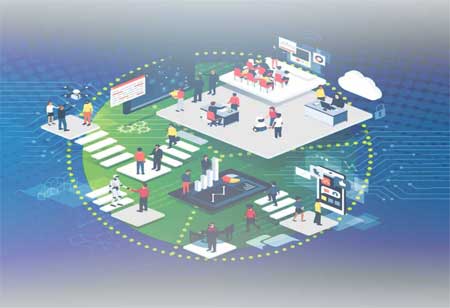THANK YOU FOR SUBSCRIBING
Emerging Technology Trends: Shaping the Future of Work and Life
The Internet of Things (IoT) is rapidly evolving, and its successful future relies on harnessing Advanced Application Programming Interfaces (APNs).

By
Apac CIOOutlook | Tuesday, October 31, 2023
Stay ahead of the industry with exclusive feature stories on the top companies, expert insights and the latest news delivered straight to your inbox. Subscribe today.
Advanced APNs are crucial for IoT's future, enhancing connectivity, security, and data management for widespread IoT applications, creating a more connected and efficient world.
FREMONT, CA: The Internet of Things (IoT) is rapidly evolving, and its successful future relies on harnessing Advanced Application Programming Interfaces (APNs). As the world becomes more interconnected, IoT devices play a crucial role in transforming industries, such as healthcare, agriculture, smart cities, and manufacturing. Advanced APNs serve as the backbone for these devices, enabling seamless communication, data exchange, and control. In this constantly expanding landscape, it is crucial to explore the latest advancements and trends in APNs to unlock the full potential of IoT.
Redefining the Role of Private APNs and Balancing Efficiency with Security
In the past, private APNs within enterprise private networks (VPN) served as the foundation for IoT connectivity in businesses. These VPNs guarantee a secure and persistent connection for IoT devices, facilitating smooth communication between devices and their associated applications. However, with increasing demands, this approach is undergoing a significant evolution.
Mobile operators now employ a single APN for multiple enterprise clients, maintaining traffic segregation and providing one or multiple VPNs to each client. Automation is a key factor in this process. Traditional setups required time-consuming VPN establishment, sometimes stretching over months. In contrast, contemporary systems allow clients to autonomously configure their VPNs within minutes.
Additionally, using a single shared APN offers several advantages. Firstly, making changes no longer requires laborious updates to the APN on thousands of devices, which becomes especially complex when these devices are in remote locations. With a multitenancy private APN, updates are executed centrally by rerouting traffic to an alternative VPN destination.
Most enterprises seek IoT connectivity that matches the security and control of their local area networks (LANs) within their corporate infrastructure. The challenge arises when these devices operate on global mobile networks and need to integrate with enterprise clients' partners.
A potential solution involves using an IoT connectivity control service (IoT CCS) hosted in the cloud. These services expand the coverage of Private APNs to include the global partner networks of enterprise clients without compromising security. Furthermore, by integrating global mobile network operator partners and connectivity hubs into the IoT CCS ecosystem, businesses gain access to a secure, global, software-defined wide area network (SD-WAN) instead of being limited to a traditional Private APN.
Stepping into a Global Future
Establishing an IoT CCS comes with numerous advantages. The cloud's widespread availability allows for local distribution of IoT traffic, ensuring efficient routing and security regardless of the device's location. This global SD-WAN solution meets the requirements of international IoT providers, providing a strong foundation for incorporating partner companies into their SD-WAN configurations.
In the highly competitive IoT arena, mobile operators are under pressure to provide a unified, secure, and global SD-WAN service for IoT to each customer through a single agreement, along with consistent customer support. As globalisation continues, businesses are increasingly seeking IoT connectivity solutions that offer uniform service quality across international boundaries.
The traditional private APN, coupled with a single enterprise VPN, often proves insufficient. Many businesses have found that effectively segregating their IoT traffic requires dividing the traffic from a device into multiple VPN connections. For example, when considering global connectivity, specific traffic needs to exit locally while still being protected by firewalls. Conversely, sensitive data is transmitted securely through enterprise VPN tunnels to reach the IoT device suppliers and their partners. Achieving this level of flexibility and security is unattainable with a conventional mobile core infrastructure; it requires the functionality of SD-WAN within a multitenancy private APN.
Consistency in service delivery and control is essential, whether the traffic is directed through roaming or involves the use of localised eSIMs. In certain markets, legal and commercial requirements necessitate device localisation. However, localising a device through eSIM often means that the mobile operator cedes control to the local operator. To maintain control over the IoT device, even after localisation, service providers connect the local partner network to their IoT connectivity hub. By default, the traffic is routed through the home location using the same APN name consistently. If the need arises for local traffic routing, the mobile operator establishes IoT connectivity service nodes at the nearest location provided by hyper-scalers.
Traditionally, the teams responsible for a mobile operator's core and business support system (BSS) prioritise stability and tend to be cautious when it comes to adopting changes, especially those recommended by perceptive clients. However, with an IoT CCS service, operators break free from these limitations. This newfound flexibility enables them to foster innovation and create IoT services that were previously unfeasible within the stringent boundaries of the 3GPP environment. Consequently, mobile operators gain the ability to customise their IoT connectivity services to meet the unique requirements of various customer segments.
Navigating the future of IoT relies on harnessing Advanced APNs. These advanced connectivity solutions enable seamless data transmission, ensuring IoT devices communicate effectively. They enhance security, reduce latency, and optimise data management. This facilitates the expansion of IoT applications across various sectors, from smart cities and healthcare to manufacturing and agriculture. The convergence of APNs and IoT promises a more connected and efficient world, where data-driven insights and automation play pivotal roles.





